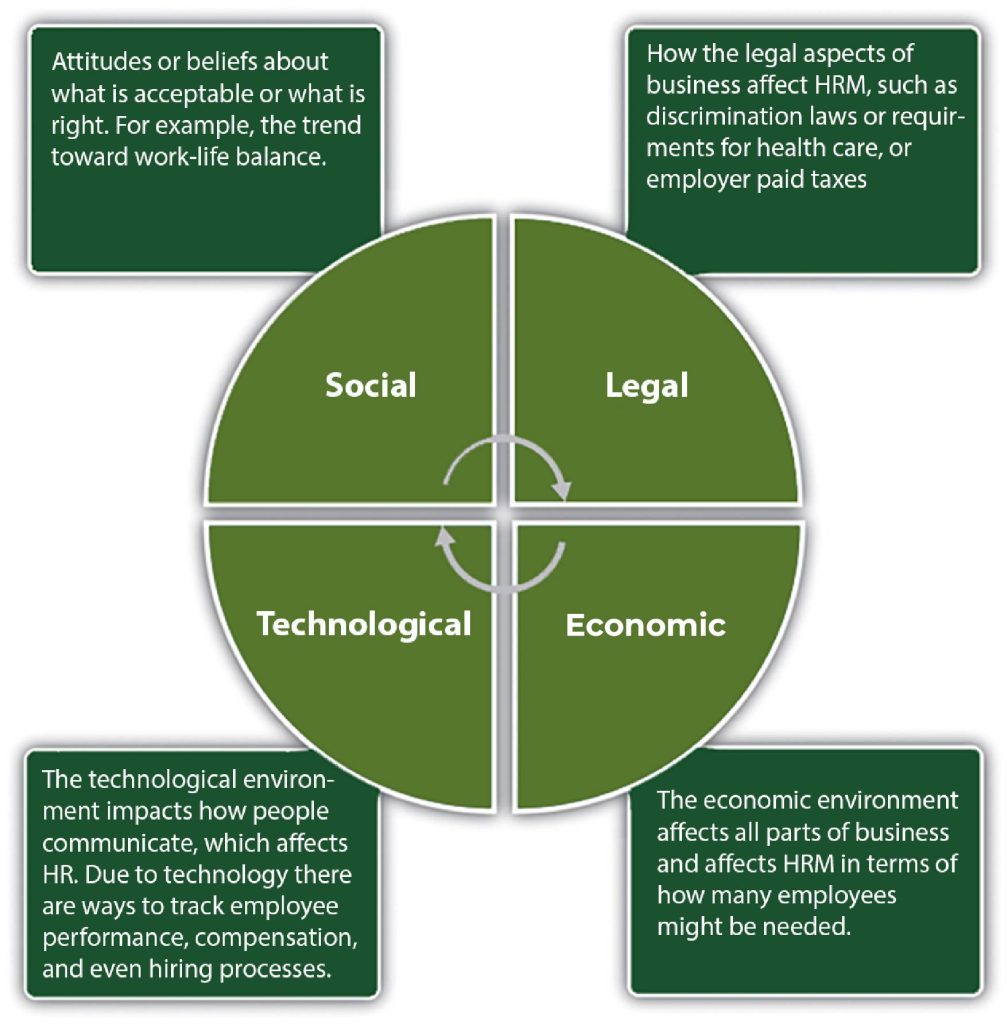1.3 External Factors
In addition to managing internal factors, the HR manager needs to consider the outside forces at play that may affect the organization. Outside forces, or external factors, are those things over which the company has no direct control but which could positively or negatively impact human resources. The HR manager has to be aware of these outside issues so they can develop policies that meet not only the needs of the company but also the needs of the employees.
External factors fall into four categories: social, legal, technological and economic.

Image Description
The image lists four factors that affect Human Resources departments externally and provides a summary of their impact.
- Social – Attitudes and beliefs about what is acceptable or what is right. For example, the trend toward work-life balance.
- Legal – How the legal aspects of business affect HRM, such as discrimination laws or requirements or requirements for health care, or employer-paid taxes.
- Technological – The technological environment impacts how people communicate, which affects HR. Due to technology, there are ways to track employee performance, compensation, and even hiring processes.
- Economic – The economic environment affects all parts of business and affects HRM in terms of how many employees might be needed.
Employment Law
It is very important that Human Resource managers are aware of all the laws that affect the workplace and ensure the processes in place abide by them. In Canada, both federal and provincial legislation play a role in shaping recruitment practices. An HR manager will work within the following legal frameworks:
- Discrimination Laws
- Health and safety requirements
- Compensation and benefits requirements (e.g., minimum wage and holidays)
- Labour laws
The legal environment of HR is always changing. Therefore, HR must always be aware of these changes taking place and communicate them to the entire management organization. Specifically with hiring processes, the law is very clear on fair hiring that includes all individuals applying for a job.
Technology

Technology has greatly impacted Human Resources and will continue to do so as new technology is developed. Through the use of technology, many companies have virtual workforces that perform tasks from nearly all corners of the world. When employees are not located just down the hall, their management creates some unique challenges.
Technology also enables a workforce that expects to be mobile. Because of the ability to telework, work from home or anywhere else, many employees may request and even demand a flexible work schedule to meet their own family and personal needs.
The recent trend in flexible work schedules and telework is an external factor that has affected HR. It is an understatement to say the COVID-19 crisis in 2020 had an impact on organizations in a major way. During COVID-19, telework became the new normal and many employees experienced the positive effects of working from home, such as a flexible work schedule, less commuting time, and lower stress of travel to the office. As a result, employee expectations have changed, with employees searching out organizations offering work-life balance.
Many companies are going a step further and creating virtual organizations which don’t have a physical location and allow all employees to work from home or the location of their choice. As you can imagine, these are all new issues for the HR manager to address.
The use of smartphones and social networking has impacted human resources, as many companies now disseminate information to employees via these methods. Social networking sites allow organizations to reach large audiences with their job postings and to find and attract potential candidates.
A large variety of databases is available to help companies organize and manage people-related data. Larger organizations rely on Human Resources Information Systems (HRIS) to capture a vast amount of information about employees. Because all this information is housed in one location, it serves as a single source of accurate data and often allows users to create reports that can be used to identify trends and make business decisions. Using an HRIS, HR managers can, in just a few clicks, find out the average salary of a junior payroll administrator in the head office.
While the HRIS is responsible for collecting and organizing HR data, HR analytics is the process of analyzing this data in order to improve an organization’s workforce performance.
Of course, the major challenge with technology is its constantly changing nature, which can impact all practices in HR management (HRM).
Economy
The overall state of the economy has a major impact on how many employees a company needs. When the economy is strong, businesses grow and often need to hire more workers. But when the economy slows down, companies may stop hiring or even lay off employees. If unemployment is low, it becomes harder to find skilled workers, so employers may offer higher pay, better benefits, or extra perks to attract and keep staff. In hard times, companies might cut back on staff by laying people off, offering early retirement, or using voluntary leave programs for employees who choose to leave early. HR helps the company plan ahead by looking at the economy and figuring out how many employees will likely be needed in the future.
Changing and Diverse Workforce
The retirement of baby boomers will result in the loss of a major part of the working population, and there are not enough people to fill those jobs left vacant. This will create a unique staffing obstacle for Human Resources and managers alike as they try to find talented people in a pool that doesn’t have enough people to perform the necessary jobs.
Another challenge is the multigenerational workforce in Canada. Employees between the ages of seventeen and sixty-eight (or older!) have different values and different expectations of their jobs.
Awareness of the diversity of the workforce is crucial. Diversity refers to age, disability, race, sex, ethnicity, and religion. Each of these components makes up the Canadian workforce, and each employee has different needs, wants, and goals. This is why it is imperative for the HR professional to engage in inclusive recruitment while also ensuring that laws are adhered to.
Working Together- Indigenous Recruitment and Retention in Remote Canada
The Government of Canada has published a guide: Working Together-Indigenous Recruitment and Retention in Remote Canada to help employers develop effective recruitment and retention strategies suitable for Canada’s Northern and remote regions.
The guide includes 12 recommendations, such as partnering with Indigenous communities on recruitment campaigns and designing job opportunities. This will help employers improve their outreach efforts in Indigenous communities. Also, as non-essential requirements may prevent otherwise qualified candidates from applying, the guide suggests that employers adjust their hiring process to meet Indigenous realities.
One solution was for the employers to offer pre-employment training. Training can be foundational (how to deal with difficult situations, how to obtain a driver’s license, how to open a bank account) or can be focused on technical skills acquisition. By investing in this training, employers can ensure that Indigenous people are prepared to succeed in their roles, building confidence on the part of the employee and employer. For this training to be successful, employers should ensure that it is delivered through culturally competent methods that respect Indigenous cultures and life experiences.
To stay on top of best practices, employers will need to ensure they understand the movement toward reconciliation and be familiar with framing documents such as the United Nations Declaration on the Rights of Indigenous Peoples and the Truth and Reconciliation Commission’s Calls to Action.
“8. Human Resources” from Management of the Enterprise by Ontario Tech University OER Lab is licensed under a Creative Commons Attribution-NonCommercial-ShareAlike 4.0 International license, except where otherwise noted.—Modifications: Used two paragraphs of Awareness of external factors; Used section Technology, rewritten to update; Used section The changing and diverse workforce, edited for brevity.
“1. Human Resource Management: An Introduction” from Human Resources Management – Canadian Edition by Stéphane Brutus and Nora Baronian is licensed under a Creative Commons Attribution-NonCommercial-ShareAlike 4.0 International License, except where otherwise noted.—Modifications: Used section Legislation and HRM.
“2.7 Human Resources Information Systems (HRIS) and HR Analytics” from Human Resources Management – 3rd Edition by Debra Patterson is licensed under a Creative Commons Attribution-NonCommercial-ShareAlike 4.0 International License, except where otherwise noted.—Modifications: Used paragraph four.

